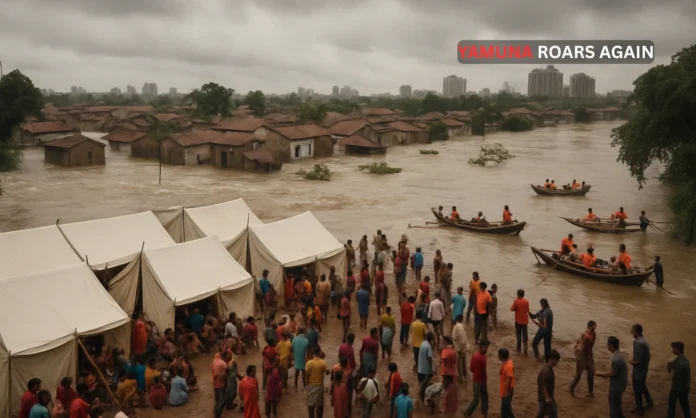Key Highlights:
- Over 18,000 people displaced across Delhi with the Yamuna flooding reaching 207.48 metres, the third-highest level in 63 years
- Critical health crisis emerges in relief camps with widespread fever, infections, and skin diseases among displaced families
- Complete livelihood destruction for farmers and daily wage earners, with entire crop harvests wiped out by floodwaters
Opening Text
Delhi’s Yamuna flooding has transformed from a natural disaster into a humanitarian emergency, with thousands of families struggling to survive in overcrowded relief camps while their homes remain submerged. The Yamuna flooding has left an indelible mark on the capital’s most vulnerable communities, creating a cascade of challenges that extend far beyond the initial water surge.
Yamuna River Floods Delhi: Thousands Evacuated
— UnreadWhy (@TheUnreadWhy) September 3, 2025
As the Yamuna River swells past 207 meters, Delhi's low-lying areas face a flood nightmare. Over 10,000 residents, including families from Mayur Vihar Phase-1, are now in relief camps under flyovers, battling makeshift living… pic.twitter.com/iK2XEMLFYi
When the Yamuna flooding began in early September 2025, Ram Kishan’s worst fears materialized as he watched his entire year’s harvest disappear under rising waters. His story mirrors that of thousands of farmers whose livelihoods depend entirely on their crops, now completely destroyed by the relentless Yamuna flooding.
Health Emergency Unfolds in Delhi’s Relief Camps
The aftermath of the Yamuna flooding has created a serious health crisis within the hastily established relief camps across Delhi. Medical teams report alarming increases in fever, skin infections, and fungal diseases among the displaced population.
- Health workers document widespread cases of skin irritation and rashes from contaminated floodwater exposure
- Children under seven years show particularly high vulnerability to recurring fevers and body rashes
- Elderly residents face additional complications from prolonged exposure during evacuation processes
- Medical facilities remain overwhelmed with approximately 322+ people housed in individual camp locations
Dr. Sharma, working at the Kashmiri Gate relief camp, emphasizes the severity of health conditions stemming from the Yamuna flooding aftermath. “Children and elderly persons are showing signs of prolonged water exposure effects. We’re treating numerous cases of athlete’s foot, skin infections, and respiratory issues daily,” he reports.
The Delhi Disaster Management Authority data reveals over 15,000 families live in high-risk flood zones along the Yamuna, making them the first to face displacement during Yamuna flooding events. These communities consistently bear the brunt of recurring flood disasters.
Livelihood Destruction and Economic Devastation
The Yamuna flooding has created unprecedented economic hardship for Delhi’s most vulnerable populations. Farmers, daily wage laborers, and small business owners face complete financial ruin as their primary income sources vanish overnight.
- Agricultural losses include complete destruction of bottle gourd, ridge gourd, and ladyfinger crops
- Daily wage earners earning Rs 300-400 daily now face months without income
- Small vendors and shopkeepers report extensive inventory losses from flood damage
- Debt burdens increase as families had borrowed money for previous repairs, now requiring additional reconstruction
Ram Kishan’s testimony illustrates the devastating impact of Yamuna flooding on agricultural communities: “All my fields have gone under water. This year’s entire harvest is gone, and my family completely depended on it”. His situation reflects the broader agricultural crisis affecting thousands of farming families.
The economic impact extends beyond individual losses. Government data shows the Delhi Irrigation and Flood Control Department failed to spend Rs 150 crore allocated for drainage improvements, highlighting systemic preparation failures that amplify Yamuna flooding consequences.
Relief Camp Struggles and Survival Challenges
Life in Delhi’s Yamuna flooding relief camps presents daily survival challenges for displaced families. More than 18,000 people now live in temporary shelters across 38 locations, facing overcrowding, inadequate sanitation, and limited privacy.
- Over 8,000 people housed in makeshift tents with 2,030 additional residents in permanent shelters
- Severe mosquito infestations create additional health risks, particularly affecting children
- Food distribution consists primarily of rice, creating nutrition concerns for fever patients
- Privacy becomes non-existent with families cramped into small shared spaces
Shanti, a Yamuna Khadar resident, describes the harsh realities: “We face a lot of trouble here at night because of the mosquitoes. Even the food we get mostly has rice. For those who have a fever, how will they manage to eat only rice?”
Families develop innovative survival strategies within the camps. At Khel Gaon camp, 19-year-old Arun sells rescued plants from his flooded nursery to support his family, while others create informal markets for basic necessities.
Government Response and Official Statistics
Delhi authorities activated comprehensive emergency response protocols as Yamuna flooding reached critical levels. The Central Water Commission classified the situation as ‘severe’ with water levels hitting 207.48 metres at the Old Railway Bridge, approaching the historic 1978 flood record of 207.49 metres.

Delhi Yamuna Flood Response Statistics
The Delhi government announced Rs 5 crore assistance to Punjab’s flood relief efforts, demonstrating regional cooperation during the crisis. However, local infrastructure inadequacies became apparent when relief camps themselves required evacuation due to rising Yamuna flooding levels.
Water level monitoring shows the Yamuna danger mark at 205.33 metres, with evacuation protocols beginning at 206 metres. The warning level stands at 204.5 metres, providing early alert capabilities for flood management teams.
Closing Assessment
Delhi’s Yamuna flooding crisis exposes deep vulnerabilities in both infrastructure preparedness and social safety networks. While immediate emergency response efforts continue, the long-term challenges of rehabilitation, health care, and economic recovery will define the true impact of this disaster. Families like Ram Kishan’s face months of uncertainty as they navigate between contaminated homes and overcrowded relief camps, highlighting the urgent need for comprehensive flood management reforms and enhanced disaster preparedness strategies.
The human cost of Yamuna flooding extends far beyond property damage, creating generational impacts on education, health, and economic stability for Delhi’s most vulnerable communities. As water levels gradually recede, the real work of rebuilding lives and livelihoods begins for thousands of affected families.


